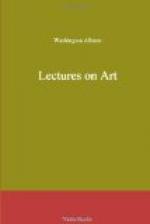That, under such disguises, we should consider human beauty as a kind of enigma, or a thing to dispute about, is not surprising; nor even that we should often differ from ourselves, when so much of the outward man is thus made to depend on the shifting humors of some paramount Petronius of the shears. But, admitting it to be an easy matter to divest the form, or, what is still more important, our own minds, of every thing conventional, there is the still greater obstacle to any true effect from the person alone, in that moral admixture, already mentioned, which, more or less, must color the most of our impressions from every individual. Is there not, then, sufficient ground for at least a doubt if, excepting idiots, there is one human being in whom the purely physical is at all times the sole agent? We do not say that it does not generally predominate. But, in a compound being like man, it seems next to impossible that the nature within should not at times, in some degree, transpire through the most rigid texture of the outward form. We may not, indeed, always read aright the character thus obscurely indexed, or even be able to guess at it, one way or the other; still, it will affect us; nay, most so, perhaps, when most indefinite. Every man is, to a certain extent, a physiognomist: we do not mean, according to the common acceptation, that he is an interpreter of lines and quantities, which may be reduced to rules; but that he is born one, judging, not by any conscious rule, but by an instinct, which he can neither explain nor comprehend, and which compels him to sit in judgment, whether he will or no. How else can we account for those instantaneous sympathies and antipathies towards an utter stranger?
Now this moral influence has a twofold source, one in the object, and another in ourselves; nor is it easy to determine which is the stronger as a counteracting force. Hitherto we have considered only the former; we now proceed with a few remarks upon the latter.




